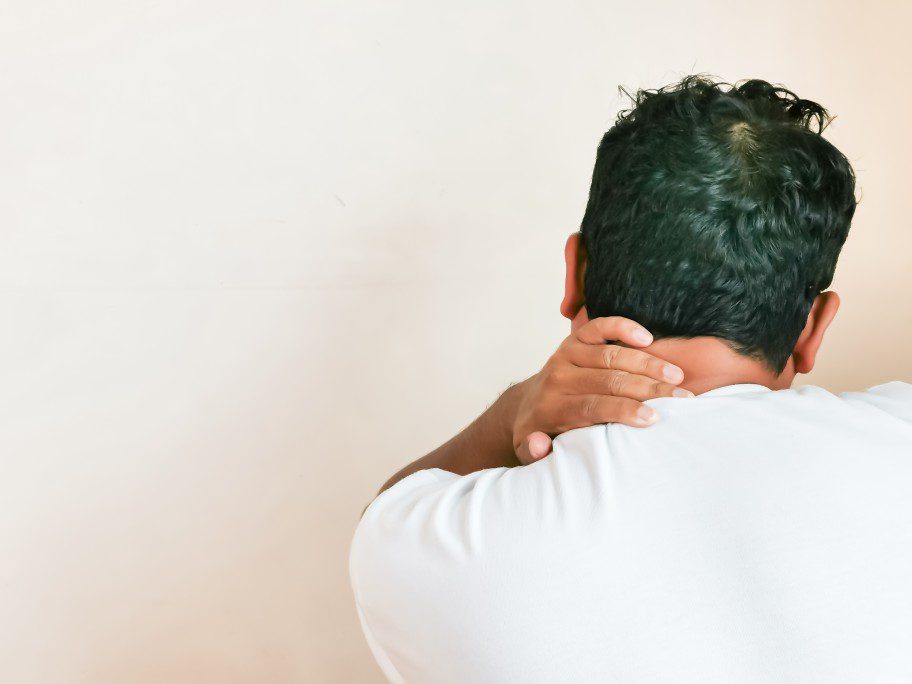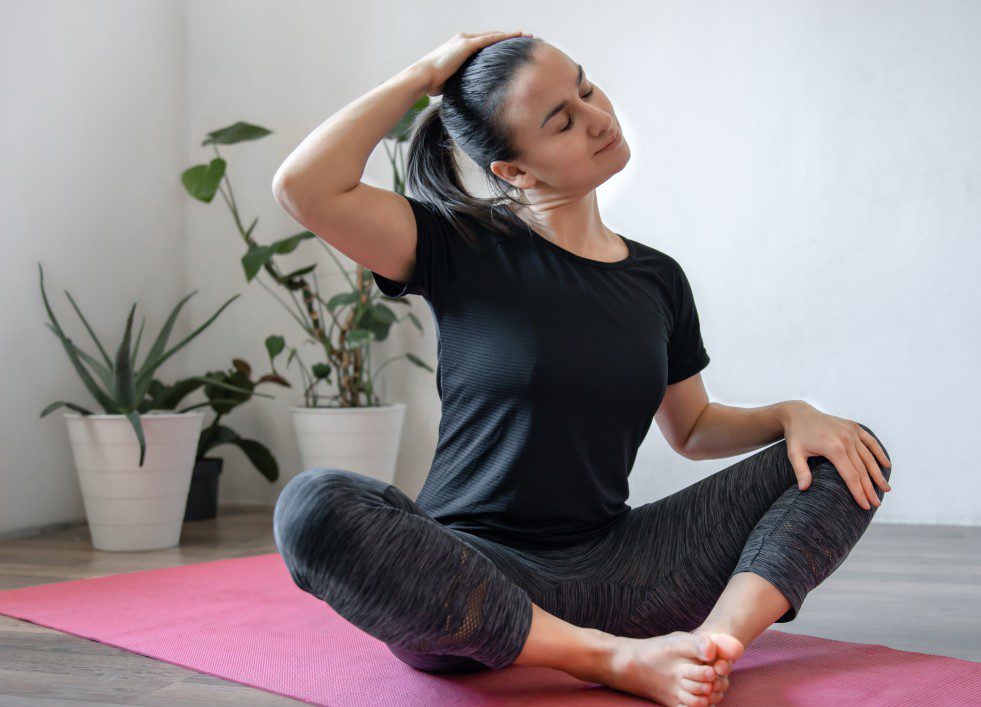

How to Fix Nerd's Neck
Nerd's neck is a condition where the neck assumes a forward lean due to lifestyle habits and other causes.
The Anatomy of the Neck
The neck is made up of two main groups of muscles;
Superficial muscles
They are located at the side of the neck and are responsible for neck rotation and support of the head during movement. Therefore, they are subject to pain or soreness in the case of Nerd's Neck.
They consist of the following:
- Platysma
It connects the jaw bone to the shoulders and the upper chest along the collar bone.
The platysma allows chewing and some mouth movements.
- Sternocleidomastoid
It is one of the largest and most superficial neck muscles starting at the base of the skull at the mastoid process and running through the side of the neck to the clavicle.
It allows head rotation and flexion of the neck.
- Trapezius
It starts at the back of the head at the base of the skull (occipital bone), attaches at the shoulders, and extends to the middle back.
It supports movement and stability while allowing the spine to be straight for a good posture. It is one of the muscles necessary for head rotation.
Deep muscles
These work together with the superficial muscles to promote mobility and stability. They comprise posterior and anterior triangles, each having a set of muscles.
Understanding the functions of these neck muscles helps determine the root cause of neck pain. An injury or strain to one of the muscles may lead to subsequent straining of the rest to try and accommodate the pain through posture change.
Causes of Nerd's Neck

The leading cause of nerd's neck is living habits, mainly from looking down for extended periods.
Lifestyle habits can contribute to nerd's neck. These are caused by how we live and interact with the environment leading to ergonomic problems.
Medical situations that involve external or internal factors which cause improper functioning of the muscles to maintain a good posture- can also lead to nerd's neck.
Take a look at the table below for the most common reasons:
| Lifestyle Reasons | Medical Reasons |
| Staring down at your phone screen | Trauma to the neck |
| Use your shoulders to support your head when seated | Weak neck muscles |
| Bench pressing or lifting weights in the gym with a raised head | Osteoporosis |
| Profession involving a lot of head movements, such as a Barber or hairstylist. | Cervical spine arthritis |
| Lifting your head to watch TV | Bulging disks |
| Sleeping with raised or many pillows Sleeping on a raised surface like the couch armrest | |
| Driving for long periods |
How To Check for Nerd's Neck:
Nerd neck at its prime has no noticeable signs, and you might even have it. However, there are two simple tests you can complete at home to give you an insight:
Wall check
Stand with your heels, back, and palms against the wall. Align your feet and shoulders at the same level and squeeze your shoulder blades to bring your chest out.
When you release your shoulder blades, does the back of your head still touch the wall? If not, you might have a developing forward head posture.
Photo check
Take or have someone take a photograph of your side profile facing away from the camera. Ideally, drawing a straight line through your spine from the head to the hips should include most vertebrae.
If your head is out of the line, you may have some degree of nerd's neck.
Symptoms
Nerd neck at its prime may have unnoticed effects on the patient. Unchecked, the results may become adverse, requiring more medical action.
Some of the red flags include:
- Rounded shoulders (kyphosis) and upper back
- Neck pain
- Back pain
- Shoulder pain
- Breathing problems
- Insomnia
- Chronic fatigue
How To Get Rid of Nerd's Neck
To prevent you or your family from developing the condition, you can make a few habitual changes.
Avoid carrying heavy loads
When you carry heavy backpacks, your head shifts forward to maintain body balance. This may be the case for kids carrying bags every day to school.
The load puts a strain on the neck and back muscles. When packing your backpack, carry only essentials, for example, books or equipment you'll only need.
Reducing screen time

Excessive time on your phone or watching TV may long-term affect your posture.
When you look down on your phone or repeatedly stare up at your TV for a long time over many days, your muscles adjust to assume the position. This leads to straining of other muscles to accommodate the change.
Ergonomic changes
These are changes to how you interact with the environment. In this case, you should change habits that affect your posture.
- Sit away from the TV that allows a perpendicular view with your chin straight.
- Adjust your workplace monitor to eye level with your feet touching the ground.
- Adjust your car seat to allow you to reach the steering wheel without leaning comfortably.
- You can also change your workplace chair to an ergonomic chair with a headrest.
These measures prevent or reverse any developing effects of nerd's neck.
Exercise
Several stretches and exercises may help keep your neck healthy.
- Chin tilts
This exercise works the front part of the neck and the shoulders.
With a straight back, touch your chin to your chest multiple times while holding the position for 30 seconds. When returning to the neutral position, do so slowly to relieve any tension in these areas.
- Neck rotation

This exercise targets the sides of the neck and the back.
Slowly rotate your neck, leaning your head towards your shoulders clockwise. Do this a few times, then switch to an anticlockwise motion.
- Cat-cow pose
While this exercise targets the middle back, it also works the neck.
Go on all fours with your head facing the ground and maintain your palms at shoulder length.
Slowly arch your middle back in as you inhale. Maintain this position for a few seconds, then exhale as you arch your back outwards.
Treatment Options
If you are diagnosed with forwarding neck posture, various treatment alternatives for the condition are available.
Three main muscles work to position and balance the head. A strain in any of these muscles leads to neck pain. Exercising this muscle will help to deter nerd's neck.
- Sternocleidomastoid
Sit with your back straight and chest out to have an upright posture.
To stretch the left part of these muscles, tilt your head to the right and hold for a few seconds till you feel the effect on your neck.
Do the same with your right side while holding your chest in using the similar arm side, for instance, your left hand when stretching the left side.
- Anterior scalenes
To work this part of the neck, repeat the Sternocleidomastoid stretch but add a twist to your tilt by touching your ear to the shoulder.
- Suboccipitals
Using a bottle, place it on the back of the neck- tuck your head in and out repeatedly to work the muscles.
Use a tennis ball on either side of the neck to work the individual muscles.
Doing chin tucks on the floor with your head lifted helps strengthen other neck muscles.
- Ergonomic work station
Ergonomic changes involve changing how we interact with the environment regarding our physical well-being.
Replacing your chair with an ergonomic chair may help with your posture problems. A head support and armrest help maintain your head position relative to your shoulders to keep your neck and back straight.
When driving, a back brace helps prevent your back from arching back.
- Visit a chiropractor
A chiropractor specializes in the spine and other joints' natural position and puts them back in place if there is any misalignment.
- Postural fixes and posture correctors
Various posture problems may lead to nerd's neck. These are caused when the body adjusts to these changes to allow the neutral head position.
They include;
Thoracic kyphosis/ Slouching forward is caused by slouching the shoulders in a near bend like you are carrying something heavy with straight arms.
Swayback/ Leaning back: The upper back is pushed back to make the tummy protrude.
Lumbar lordosis/ Arching forward: The middle back is pushed ahead, lifting the lower back and buttocks. The chest protrudes to balance the body.
Posture correctors are used to bringing awareness of someone's posture. If you are used to straining specific muscles, you will be restrained when you assume poor posture.
- Medication

Some medicine and other treatment options may be prescribed for forwarding head posture.
Over-the-counter pain relief medication may alleviate pain while allowing for the muscles to heal in the correct posture. This can be supplemented with physiotherapy and short-term use of posture correctors.
- Natural treatment
Keep in mind that other trigger points may cause neck pain due to nerd's neck. A change in posture may result from body adjustments to relieve pain in certain areas.
Various types of natural treatments aim to find a source of pain and release tension in the trigger points.
- Nerve Flossing
It is an exercise often used with other treatment plans to help improve mobility range of motion and alleviate pain.
- Myofascial release
This type of physical therapy is used to treat Myofascial pain by finding the pain spots over a broad muscle and tissue area. It aims to reduce tension and the tight regions of the Myofascia.
FAQs
Why isn't my neck pain stopping?
When doing exercises or fixes for neck pain, the pain is usually felt at a localized location but caused at a different one. It is essential to work on the sources of pain.
These areas may not be the areas you feel the pain, but they lead to it. The back is one such area. Fixing back and shoulder-related issues and posture problems may relieve pain in the neck.
Do posture correctors work?
Posture correctors train someone with postural problems to maintain the correct posture.
This makes them a short-term solution to posture problems rather than a long-term one. If someone uses a posture corrector like a brace, they should use it for short-term periods to correct their posture.
Prolonged use of these items may lead to more damage or muscle weakness as posture maintenance becomes dependent on the correctors.
About Dr. Sean Ormond



